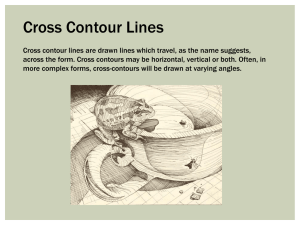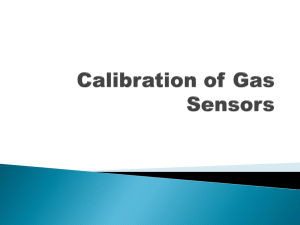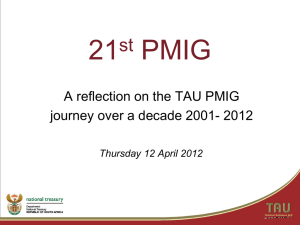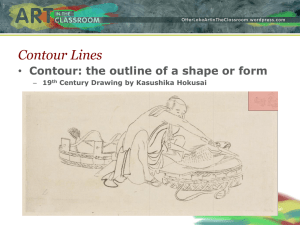aFucosylation
advertisement
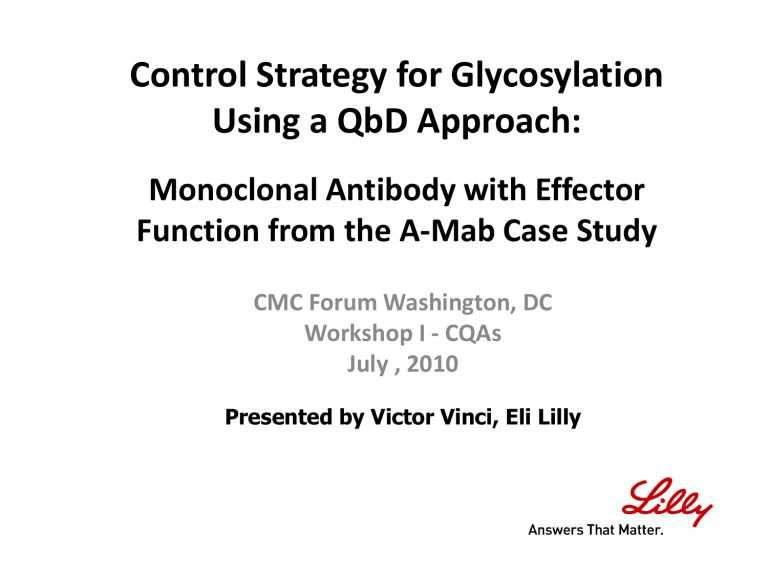
Control Strategy for Glycosylation Using a QbD Approach: Monoclonal Antibody with Effector Function from the A-Mab Case Study CMC Forum Washington, DC Workshop I - CQAs July , 2010 Presented by Victor Vinci, Eli Lilly CMC BWG – A-Mab Case Study Working Group Members • • • Amgen Team: Joseph Phillips (Lead), Bob Kuhn Abbott Team: Ed Lundell (Lead), Hans-Juergen Krause, Christine Rinn, Michael Siedler, and Carsten Weber Eli Lilly Team: Victor Vinci (Lead), Michael DeFelippis, John R Dobbins, Matthew Hilton, Bruce Meiklejohn, and Guillermo Miroquesada Genentech Team: Lynne Krummen (Lead), Sherry Martin-Moe, and Ron Taticek GSK Team: Ilse Blumentals (Lead), John Erickson, Alan Gardner, Dave Paolella, Prem Patel, Joseph Rinella, Mary Stawicki, Greg Stockdale MedImmune Team: Mark Schenerman (Lead), Sanjeev Ahuja, Laurie Kelliher , Cindy Oliver , Kripa Ram, Orit Scharf, and Gail Wasserman Pfizer Team: Leslie Bloom (Lead) and Amit Banerjee, Carol Kirchhoff, Wendy Lambert, Satish Singh Facilitator Team: John Berridge, Ken Seamon, and Sam Venugopal • Plus help from many others • • • • • Vinci/Defelippis - CMC BWG QbD Case Study Lilly - Company Confidential 2010 2 Creating a Biotech Case Study: “A-Mab” • Based on a monoclonal antibody drug substance and drug product – – – – – – “A-Mab” Humanized IgG1 (w/ effector function) IV Administered Drug (liquid) Expressed in CHO Cells Treatment of NHL Molecule designed to maximize clinical outcomes and minimize impact on quality attributes (TPP) • Publically and freely available as a teaching tool for industry and agencies at CASSS or ISPE Vinci/Defelippis - CMC BWG QbD Case Study Why Monoclonal Antibody? Represents a significant number of products in development Good product and process exp. in dev. & manufacture Reasonable level of complexity Lilly - Company Confidential 2010 3 QbD Development Paradigm Creation of a Control Strategy Animal In-Vitro Studies Studies Input Material Controls High Criticality Attributes Product Quality Attributes Procedural Controls 1.Quality attributes to be considered and/or controlled by manufacturing process Criticality Assessment 2. Acceptable ranges for quality attributes to ensure drug safety and efficacy Process Targets for Quality Attributes Process Development and Characterization Design Space Control Strategy Elements Safety and Efficacy Data Process Controls Continuous Process Verification Prior Clinical Knowledge Studies Process Parameter Controls Testing In-Process Testing Specifications Characterization & Comparability Testing Attributes that do not need to be considered or controlled by manufacturing process Process Monitoring Low Criticality Attributes Product Understanding Vinci/Defelippis - CMC BWG QbD Case Study Process Understanding Lilly - Company Confidential 2010 4 CQA Risk Ranking & Filtering Tool A Continuum of Criticality (Tool #1 Ex.) • Assess relative safety and efficacy risks using two factors: – Impact and Uncertainty used to rank risks • Impact = impact on safety or efficacy, i.e. consequences – Determined by available knowledge for attribute in question (prior, clinical, etc) – More severe impact = higher score • Impact on biological activity, PK/PD, immunogenicity, adverse effects • Uncertainty = uncertainty that attribute has expected impact – Determined by relevance of knowledge for each attribute – High uncertainty = high score (no information with variant or published lit. only) – Low uncertainty = low score (data from material used in clinical trials) Severity = Impact x Uncertainty • Severity = risk that attribute impacts safety or efficacy Vinci/Defelippis - CMC BWG QbD Case Study Lilly - Company Confidential 2010 5 Criticality Ratings for Glycosylation Attribute Criticality Aggregation 60 aFucosylation 60 Galactosylation 48 Deamidation 4 Oxidation 12 HCP 36 DNA 6 Protein A 16 C-terminal lysine variants (charge variants) 4 Glycoslyation - High Criticality • Example is for afucosylation and galactosylation; other glycan structures require individual consideration • Primarily impacted by production BioRx • No clearance or modification in DS • Not impacted by DP process or stability Note: Assessment at beginning of development Vinci/Defelippis - CMC BWG QbD Case Study Lilly - Company Confidential 2010 6 Platform and Product Specific Experience Attribute Galactose Content aFucosylation Prior Knowledge Clinical experience of 1040% G0 for YMab, another antibody with CDC activity as part of MOA; no negative impact on clinical outcome In-vitro Studies 0-100% gal content has statistical correlation w/ CDC activity w/ A-Mab Studies show that 100% G0 or 100%G2 have comparable ADCC 1-11%; Clinical A-Mab with 2experience with 13% afucosylation X-Mab and Ytested in ADCC Mab; both X-Mab assay; linear and Y-Mab have correlation; 70ADCC as part of 130% MOA Vinci/Defelippis - CMC BWG QbD Case Study Non-clinical Studies Clinical Experience Claimed Acceptable Range No animal studies 10-30% 10-40% Animal model available; modeled material (15%) shows no significant difference from 5% 2-13% Lilly - Company Confidential 2010 5-10%; Phase II and Phase III 7 CQA Linkage to Process Knowledge afucosylation and galactosylation are assigned as CQAs due to linkage to ADCC and CDC activity and proposed NHL therapeutic need Analytical characterization method for afucosylation and galactosylation is CE-LIF: Bioassay development led to a robust assay with a linear correlation between aFuc (2-13%) and ADCC activity (bioassay range of 70 – 130%) Bioassay for CDC showed no impact over the range of galactosylation (10 – 40%) produced in clinical material Ranges of afucosylation and galactosylation can be ensured by control of bioreactor process parameters found to have influence on these structures. Release testing with Biopotency assay for drug product (acceptance criterion 70 – 130%) confirms appropriate product quality Vinci/Defelippis - CMC BWG QbD Case Study Lilly - Company Confidential 2010 8 Influence of Glycosylation on ADCC and CDC Effector Functions Vinci/Defelippis - CMC BWG QbD Case Study Lilly - Company Confidential 2010 9 Experimental Design Progression of Studies for Production Bioreactor Prior knowledge and risk assessments inform designed experiments: • Risk analysis tools guide informed assessments • Risk assessment links product attributes with parameters • DOE’s allow understanding of the impact of process parameters and attributes • Risk assessments are iterative and continue through the lifecycle of product Vinci/Defelippis - CMC BWG QbD Case Study Lilly - Company Confidential 2010 10 Risk Assessment Approach Multiple Assessments Throughout the A-Mab Development Lifecycle for Entire Process Process 2 Quality Attributes Process 1 2 Life Cycle Management Design Space Prior Knowledge Process Understanding Process Development Process Characterization Product Understanding Draft Control Strategy Process Performance Verification Final Control Strategy Process Parameters Risk Assessment Risk Assessment Risk Assessment Risk Assessment You Are Here Vinci/Defelippis - CMC BWG QbD Case Study Lilly - Company Confidential 2010 11 Example of Risk Assessment Tool Approach to Process Characterization Step 1. Use a Fish-bone (Ishikawa) diagram to identify parameters and attributes that might affect product quality and process performance Agitation Production Bioreactor N-1 Bioreactor In Vitro Cell Age Seed Seed Density Viability Temperature Shear/ Mixing Working Volume Harvest # of Impellers CO2 DO Control Parameters Scale Effects pH Nominal Vessel Volumne Design Impeller Design Duration Baffles Procedures Gas Transfer Temperature pH Airflow Sparger Design Aggredates Fucosylation Galactosylation CEX AV HCP DNA Antifoam Time of Feeding Filtration Volume of Feed Operations Amount Delivered Storage Temperature Concentration Preparation pH Pre-filtration hold time Procedures Age Number of Feeds Age Operations Procedures Storage Temperature Pre-filtration hold time [Antifoam] Age [NaHCO3] Timing Preparation Osmolality Filtration Feed Vinci/Defelippis - CMC BWG QbD Case Study [Glucose] Glucose Feed Lilly - Company Confidential 2010 Medium Concentration 12 A-Mab: Mid-Development Risk Assessment Approach Rank parameters and attributes from Step 1 based on severity of impact and control capability. Identify interactions to include in DOE studies Inoculum Viable Cell Concentr Inoculum Viability Inoculum In Vitro Cell Age N-1 Bioreactor pH N-1 Bioreactor Temperature Osmolality Antifoam Concentration Nutrient Concentration in medium Medium storage temperature Medium hold time before filtration Medium Filtration Medium Age Timing of Feed addition Volume of Feed addition Component Concentration in Feed Timing of glucose feed addition Amount of Glucose fed Dissolved Oxygen Dissolved Carbon Dioxide Temperature pH Culture Duration (days) Remnant Glucose Concentration Vinci/Defelippis - CMC BWG QbD Case Study Risk Mitigation Viability at Harvest Turbidity at harvest Product Yield DNA Process Attributes HCP Deamidation Galactosylation aFucosylation Process Parameter in Production Bioreactor Aggregate Quality Attributes DOE Linkage Studies EOPC Study Linkage Studies Linkage Studies DOE Not Required Potential impact to significantly affect a process attribute such as yield or viability DOE Medium Hold Studies Medium Hold Studies Medium Hold Studies Medium Hold Studies Not Required DOE Potential impact to QA with effective control of parameter or less robust control DOE DOE-Indirect DOE-Indirect DOE DOE DOE DOE DOE DOE-Indirect Lilly - Company Confidential 2010 Note: pH is red or critical at this stage due to linkage to glycosylation 13 MCC Bioreactor Control Strategy Elements by System - pH Raw Materials (Reg/QMS) – vendor qualification; media (or buffer) make-up based on instructions, weight based; pH check post make-up Equipment (QMS) – bioreactor design (probe type/placement), probe vendor qualification, receipt verification, linked to IQ/OQ and PV for bioreactor Automation (QMS) – control loop qualified (CSV) and controlled via DCS, alert/action alarms aligned with process, data monitored continuously and archived DOE and Models (QMS/Reg) – small-scale models use parameter ranges intended for large-scale; confirm during pivotal and commercial tech transfer In Process/Operations (QMS) – pH probe calibration (pre-run), batch record instructions on how to do daily check and adjustment, data trended Specification Limits/Tests (Reg/QMS) – Control Strategy in place, validated methods reflecting QbD analytical development Process Verification/Continuous Monitoring (QMS/Reg) – MVA (PLS) or SPC monitoring of performance over manufacturing lifecycle Vinci/Defelippis - CMC BWG QbD Case Study Lilly - Company Confidential 2010 14 Continuity of Ranges Attributes and Parameters in Study Levels of CQAs: CQA Afucosylation (%) Galactosylation (%) Lower Limit 2 10 Higher Limit 13 40 Parameter Ranges: Platform (2 liters and at-scale FHD) Screening Study (Central Composite) Design Space Proposal Batch Record (Pivotal and Comm.) Automation Alarms pH 6.6 – 7.1 (initial set pt*) pH 6.6 – 7.1 (2 liter) pH 6.6 -7.1 (commercial) pH 6.95 (initial ref pt) pH 6.85 lo/pH 6.95 hi alert-control space pH 6.7 lo/pH 7.1 action-design space *Note that pH variable is set at initial as ref pt and moves through low (base) and high (acid or CO2) control Vinci/Defelippis - CMC BWG QbD Case Study Lilly - Company Confidential 2010 15 DOE Studies to Define Design Space Bringing Together Process and Product Attributes Example of DOE Results from Screening Study (Process 2). N=20. Prediction Profiler Titer (g/L) 3.743131 ±0.076052 5 4 HCP (ppm) Galactosylation aFucosylation 695538 (%) 6.439933 ±16518.3 29.28939 ±0.226948 ±0.674582 3 8 6 4 32 28 24 2500 2000 1500 32 28 24 3.0 2.6 2.2 35 Temperature (C) 50 DO (%) Vinci/Defelippis - CMC BWG QbD Case Study 100 CO2 (%) 6.85 pH 1.2 [Medium] (X) 400 Osmo (mOsm) Lilly - Company Confidential 2010 12 Feed (X) 1 IVCC (e6 cells/mL) 19 -0.1 .1 .3 .5 .7 18 17 16 440 9 10 11 12 13 14 15 .7 .8 .9 1 1.1 1.2 1.3 15 420 400 380 1.6 360 1.4 1.2 1 7 7.1 .8 6.9 6.8 6.7 70 40 60 80 100 120 140 160 6.6 60 50 40 36 30 35 35.5 34.5 1.8 34 Aggregates (%) 2.515119 ±0.03524 CEX % Acidic Variants 27.66898 ±0.480814 DNA (ppm) 1935.343 ±89.55908 1e+6 8e+5 6e+5 4e+5 17 Duration (d) 0.21 Curvature 16 Moving Toward Design Space Follow-up Studies and Analysis Augment the screening design to enable estimation of a full response surface: all main effects two-way interactions quadratic effects Additional runs form Central Composite Design (when comb. w/ previous runs): 8 additional runs form full factorial on important parameters. 8 axial points allow to estimate non-linear relationships 4 parameters and 6 QA’s (responses) N=40 total bioreactor runs (4 blocks of 10, ~12 weeks) 8 center points total Response surface model captures all input – output relationships and is suitable to define the design space Vinci/Defelippis - CMC BWG QbD Case Study Lilly - Company Confidential 2010 17 Contour Profiler Contour Profiler Horiz Vert Factor Temperature (C) DO (%) CO2 (%) pH [Medium] (X) Osmolality (mOsm) Feed (X) IVCC (e6 cells/mL) Culture Duration (days) Current X 35 50 100 6.85 1.2 360 12 1 15 Horiz Vert Factor Temperature (C) DO (%) CO2 (%) pH [Medium] (X) Osmolality (mOsm) Feed (X) IVCC (e6 cells/mL) Culture Duration (days) Current X 34.999293 50 100 6.85 1.2 440 12 1 15 Develop Multivariate Models to define Design Space Response Titer (g/L) aFucosylation Galactosylation (%) HCP (ppm) DNA (ppm) CEX % Acidic Variants Aggregates (%) Contour Current Y Lo Limit Hi Limit Contour Profiler 0 4.8 . . Horiz Vert Factor 11 8.3 2 11 Temperature (C) 40 33.4 20 40 DO (%) 15000000 513494.5 . 15000000 CO2 (%) 19000 1471.7 . . pH 40 28.2 20 40 [Medium] (X) 3 1.3 . 3 Osmolality (mOsm) Feed (X) IVCC (e6 cells/mL) Culture Duration (days) Response Titer Current X (g/L) aFucosylation 35 Galactosylation (%) 50 HCP 70 (ppm) DNA (ppm) 6.85 CEX 1.2 % Acidic Variants Aggregates (%) 400 Design Space for Culture Duration 15 Days Osmolality 7 Response Titer (g/L) 6.9 Factor Horiz Vert 360mOsm 400mOsm Current X aFucosylation Temperature (C) 35 Galactosylation (%) 50 6.8 DO (%) HCP (ppm) CO2 (%) 40 DNA (ppm) pH 6.85 6.7 CEX % Acidic Variants [Medium] (X) 1.2 Aggregates (%) Osmolality (mOsm) 360 aFucosylation 6.6 Feed (X) 12 7.1 IVCC (e6 cells/mL) 1 34 Duration 34.5 (days) 35 35.5 36 Culture 15 7 Temperature (C) Response Contour Current Y Lo Limit Hi Limit Titer (g/L) 0 5.2 . . 6.9 aFucosylation 11 9.8 2 11 160 mmHg Galactosylation (%) 40 36.8 20 40 100 mmHg 6.8 HCP (ppm) 15000000 469303.1 . 15000000 DNA (ppm) 19000 1465.4 . . 40 mmHg CEX % Acidic Variants 40 20 40 6.7 33.1 Aggregates (%) 3 1.3 . 3 pH >11% 12 7.1 1 15 Galactosylation (%) <20% pH >40% 36 Contour 0 2 40 15000000 19000 40 3 Current Y 4.5 6.6 34.4 458789.8 1479.0 31.0 1.3 One model for each CQA: describes relationships with CPPs Lo Limit . 2 20 . . 20 . 6.6 7.1 Contour Profiler Galactosylation (%) 36 >40% Osmolality 6.6 36 34 34.5 Contour Current Y Lo Limit 0 5.4 . Contour Profiler 2 4.3 2 20 24.8 20 Horiz Vert Factor 15000000 891294.0 Temperature (C) . 19000 2459.8 . DO (%) 40 28.6 (%) 20 CO2 3 1.8 . pH pH <20% Galactosylation (%) Hi Limit . 11 40 15000000 . 40 3 36 mmHg Contour 0 2 20 15000000 19000 40 3 CO2 Horiz Vert Factor Temperature (C) 7 DO (%) CO2 (%) 6.9 pH [Medium] (X) 6.8 Osmolality (mOsm) Feed (X) 6.7 IVCC (e6 cells/mL) Culture Duration (days) 6.6 Response Titer (g/L) 34 34.5 35 35.5 aFucosylation Galactosylation (%)Temperature (C) Current X HCP (ppm) 35 DNA (ppm) 50 CEX % Acidic Variants 70 Aggregates (%) 6.85 1.2 7.1 400 12 71 19 Profiler Contour 6.9 Current Y Horiz Vert Factor 440mOsm Contour Current X Response 360mOsm 400mOsm 35 (g/L) Titer 50 aFucosylation 40 Galactosylation (%) 6.85 HCP (ppm) 1.2 (ppm) DNA 360 CEX % Acidic Variants 12 Aggregates (%) 1 19 7.1 pH 35.5 Temperature (C) Response Titer (g/L) aFucosylation 160 Galactosylation (%)mmHg 100 HCP (ppm) DNA (ppm) 40 mmHg CEX % Acidic Variants Aggregates (%) Contour 0 2 20 15000000 19000 40 3 Current Y 4.9 5.9 30.9 674274.3 1961.3 30.7 1.6 Current X 35 50 100 6.85 1.2 440 12 1 19 <20% Osmolality < 2% Horiz Vert 6.9 Factor Temperature (C) DO (%) 6.8 CO2 (%) pH 6.7 [Medium] (X) Osmolality (mOsm) 6.6 Feed (X) IVCC (e6 cells/mL) Culture Duration 34 34.5 (days) 35 36 Current Y 6.1 7 5.3 30.2 6.9 870128.1 2482.5 6.8 32.8 1.8 6.7 Lo Limit . 2 20 . . 20 . pH 7 35.5 [Medium] (X) Osmolality (mOsm) Feed (X) IVCC (e6 cells/mL) Culture Duration (days) aFucosylation 7.1 35 Temperature (C) Design Space for Culture Duration 19 Days Contour Profiler 36 pH pH Current X 35 50 100 6.85 1.2 360 12 1 19 >40% Current X 35 50 40 6.85 1.2 440 12 1 17 Galactosylation (%) Contour Profiler 7.1 Contour 7.1 Profiler Horiz Vert Factor 7 Temperature (C) DO (%) 6.9 CO2 (%) pH 6.8 [Medium] (X) Osmolality (mOsm) Feed (X) 6.7 IVCC (e6 cells/mL) Culture Duration (days) 6.6 Response Galactosylation (%) Titer (g/L) 34 34.5 35 35.5 aFucosylation Galactosylation (%) Temperature (C) HCP (ppm) DNA (ppm) CEX % Acidic Variants Aggregates (%) 0 2 20 15000000 19000 40 3 Lo Limit 5.4 Temperature (C) . 6.8 DO 5.1 2 (%) 25.9 20 CO2 (%) 900138.3 . pH 6.7 2528.5 . [Medium] (X) 30.1 20 6.6 Osmolality (mOsm) 1.8 . Feed (X) <20% 7.1 36 36 7 34.5 35 35.5 Temperature (C) 6.9 pH pH 6.9 <20% 36 6.8 6.8 6.7 6.7 6.6 Current Y 5.4 5.2 27.3 889758.9 2443.6 30.5 1.9 Lo Limit . 2 20 . . 20 . For the production bioreactor the limits of Design Space are defined by a subset of CQAs: Galactosylation aFucosylation Hi Limit . 11 40 15000000 . 40 3 Lo Limit . 2 20 . . 20 . Hi Limit . 11 40 15000000 . 40 3 All other CQAs did not exceed Quality Limits when process operated within Knowledge Space & Design Space Lo Limit . 2 20 . . 20 . Hi Limit . 11 40 15000000 . 40 3 *Note that DO and Feed Conc from earlier study are controlled in same range Galactosylation (%) 7.1 34 Current Y 4.9 4.7 21.1 898827.7 2434.0 27.0 1.9 Current X 35 50 40 6.85 1.2 440 12 1 19 Contour 0 2 20 15000000 19000 40 3 6.6 7 Contour 0 2 20 15000000 19000 40 3 Hi Limit . 11 40 15000000 . 40 3Galactosylation (%) IVCC (e6 cells/mL) 34 Duration 34.5 (days) 35 35.5 Culture Temperature (C) Response Titer (g/L) aFucosylation Galactosylation (%) HCP (ppm) DNA (ppm) CEX % Acidic Variants Aggregates (%) Hi Limit . 11 40 15000000 . 40 3 Hi Limit . 11 40 15000000 . 40 3 aFucosylation Temperature (C) Response Titer (g/L) aFucosylation Galactosylation (%) HCP (ppm) DNA (ppm) CEX % Acidic Variants Aggregates (%) CO2 Lo Limit . 2 20 . . 20 . < 2% <20% pH pH 12 Galactosylation (%) 7.1 1 17 7 Contour Current Y Lo Limit Hi Limit Contour Profiler 0 5.0 . . Horiz Vert 6.9 Factor 2 6.5 2 11 440mOsm Temperature (C) 40 29.8 20 40 DO (%) 15000000 697946.1 . 15000000 6.8 CO2 (%) 19000 2040.3 . . pH 40 30.2 20 40 6.7 [Medium] (X) 3 1.5 . 3 Osmolality (mOsm) 6.6 Feed (X) IVCC (e6 cells/mL) Culture 34 Duration 34.5 (days) 35 35.5 pH Feed (X) IVCC (e6 cells/mL) Culture Duration (days) Response Titer (g/L) Horiz Vert Factor Current X aFucosylation 6.9 360mOsm 400mOsm Temperature (C) 35 Galactosylation (%) DO (%) 50 HCP (ppm) 6.8 CO2 (%) 40 DNA (ppm) pH 6.85 CEX % Acidic Variants 6.7 [Medium] (X) 1.2 Aggregates (%) Osmolality (mOsm) 360 Feed (X) 12 6.6 7.1 IVCC (e6 cells/mL) 1 Culture Duration (days) 17 34 34.5 35 35.5 36 7 Response Contour Current Y Lo Limit Hi Limit Temperature (C) Titer (g/L) 0 5.7 . . 6.9 aFucosylation 2 7.5 2 11 160 mmHg Galactosylation (%) 40 33.5 20 40 100 mmHg HCP (ppm) 15000000 6.8 669715.6 . 15000000 DNA (ppm) 19000 1973.9 . . mmHg CEX % Acidic 40 Variants 40 6.7 32.9 20 40 Aggregates (%) 3 1.5 . 3 Intersection of all CQA models define the Design Space >40% Design Space for Culture Duration 17 Days 7.1 Contour Profiler 7.1 Horiz Vert Factor Current X 7 Temperature (C) 35 DO (%) 50 100 6.9 CO2 (%) pH 6.85 1.2 Galactosylation (%) 6.8 [Medium] (X) Osmolality (mOsm) 440 Feed (X) 12 6.7 IVCC (e6 cells/mL) 1 Culture Duration (days) 17 6.6 Response Contour Current Y Titer 0 4.6 Current X (g/L) 34 34.5 35 35.5 36 aFucosylation 2 5.2 35 Galactosylation (%) Temperature (C) 20 25.7 50 HCP 15000000 694855.9 70 (ppm) DNA (ppm) 19000 1966.2 6.85 CEX 40 26.9 1.2 % Acidic Variants Aggregates (%) 3 1.6 400 pH >11% 7 Contour Profiler Hi Limit . 11 40 15000000 . 40 3 <20% pH 34 34.5 35 35.5 Horiz Vert Factor Current X 7 Temperature (C) Temperature (C) 35 DO (%) 50 6.9 CO2 (%)aFucosylation 100 pH 6.85 [Medium] (X) 1.2 6.8 Osmolality (mOsm) 360 Galactosylation (%) Feed (X) 12 6.7 IVCC (e6 cells/mL) 1 Culture Duration (days) 17 6.6 Contour ProfilerLo Limit Response Contour Current Y Hi Limit Titer (g/L) 0 5.1 . . Horiz Vert Factor 34 34.5 35 35.5 36 aFucosylation 2 6.3 11 Temperature (C) 2 Temperature (C) Galactosylation (%) 20 29.1 20 40 DO (%) HCP (ppm) 15000000 702394.3 . 15000000 CO2 (%) DNA (ppm) 19000 1965.8 . . pH CEX % Acidic Variants 40 28.4 20 40 [Medium] (X) Aggregates (%) 3 1.6 . 3 Osmolality (mOsm) Hi Limit . 11 40 15000000 . 40 3 A better way to look at the data: Current X 35 50 40 6.85 1.2 440 12 1 15 6.6 CO2 Lo Limit . 2 20 . . 20 . < 2% Hi Limit . 11 40 15000000 . 40 3 Feed (X) IVCC (e6 cells/mL) Culture Duration (days) 34 34.5 35 35.5 Response Temperature (C) Titer (g/L) aFucosylation Galactosylation (%) HCP (ppm) DNA (ppm) CEX % Acidic Variants Aggregates (%) >11% Current Y 4.2 5.7 30.3 490873.2 1498.3 26.7 1.3 aFucosylation 7 Contour Current Y Lo Limit Contour Profiler 0 4.7 . Horiz Vert Factor 440mOsm 2 6.9 7.8 2 Temperature (C) 40 33.7 20 DO (%) 15000000 6.8 495754.0 . CO2 (%) 19000 1552.2 . pH 40 30.2 20 6.7 [Medium] (X) 3 1.2 . Osmolality (mOsm) pH 7.1 Contour Profiler Contour 0 2 20 15000000 19000 40 3 6.6 34 34.5 35 35.5 36 Temperature (C) Vinci/Defelippis - CMC BWG QbD 34 34.5 35 35.5 36 Temperature (C) Lilly - Company Confidential 2010 18 Contour Profiler Design Space Based on Process Capability Horiz Vert Factor Temperature (C) DO (%) CO2 (mmHg) pH [Medium] (X) Osmo (mOsm) Feed (X) IVCC (e6 cells/mL) Duration (d) Current X 35 50 40 6.85 1.2 360 12 1 15 Understanding Variability Example: Day 15, Osmo=360 mOsm and pCO2=40 mmHg Contour Current Y Lo Lim it Response Titer (g/L) aFucosylation Galactosylation (%) HCP (ppm) DNA (ppm) CEX % Acidic Variants 3 11 40 675000 2250 40 5.3408326 9.1879682 38.227972 466955.66 1382.1644 34.420095 3 . . . . . >99% confidence of satisfying all CQAs Hi Lim it . 11 40 . . . 50% contour approximates “white” region” in contour plot 0. 99 7.1 7.05 7 7 9 0. 0.80.7 0.5 aFucos >11% 0. 95 6.95 pH pH 6.8 Galactosylation (%) 0.99 95 0. pH 5 0.2 6.9 6.9 0. 99 0. 9 0. 8 0.7 6.85 0.99 0.5 6.8 0.25 aFucosylation Galact >40% 0.8 0.7 0.5 0.25 6.75 6.7 0.95 0.9 0.95 0.9 0.8 0.7 0.5 0.25 6.7 6.65 6.6 34 34.5 35 35.5 36 6.6 34 Temperature (C) Temperature (C) Vinci/Defelippis - CMC BWG QbD Case Study 34.2 34.4 34.6 34.8 35 35.2 35.4 35.6 35.8 36 Temperature (C) Lilly - Company Confidential 2010 19 Risk Assessment Approach Multiple Assessments Throughout the A-Mab Development Lifecycle for Entire Process Process 2 Quality Attributes Process 1 2 Life Cycle Management Design Space Prior Knowledge Process Understanding Process Development Process Characterization Product Understanding Draft Control Strategy Process Performance Verification Final Control Strategy Process Parameters Risk Assessment Risk Assessment Risk Assessment Risk Assessment You Are Here Vinci/Defelippis - CMC BWG QbD Case Study Lilly - Company Confidential 2010 20 Control Strategy for Upstream Production Quality-linked Process Parameters (WC-CPPs) Key Process Parameters (KPPs) Temperature Time Temperature pH Dissolved CO2 Culture Duration Osmolality Remnant Glucose Vinci/Defelippis - CMC BWG QbD Case Study Working Cell Bank Step 1 Seed Culture Expansion in Disposable Shake Flasks and/or bags Viable Cell Concentration Viability Temperature pH Dissolved Oxygen Culture Duration Initial VCC/Split Ratio Step 2 Seed Culture Expansion in Fixed Stirred Tank Bioreactors Viable Cell Concentration Viability Antifoam Concentration Time of Nutrient Feed Volume of Nutrient Feed Time of Glucose Feed Volume of Glucose Feed Dissolved Oxygen Step 3 Production Culture Step 4 Centrifugation and Depth Filtration Clarified Bulk In-Process Quality Attributes Viable Cell Concentration Viability Temperature Culture Duration Initial VCC/Split Ratio Flow Rate Pressure Controlled within the Design Space to ensure consistent product quality and process performance Key Process Attributes Product Yield Viability at Harvest Turbity at Harvest Bioburden MMV Mycoplama Adventitious Virus Product Yield Turbidity Controlled within acceptable limits to ensure consistent process performance Lilly - Company Confidential 2010 Assay results part of batch release specifications Slide 21 Example of Control Strategy for Selected CQAs CQA Criticality Process Capability Testing Criteria Other Control Elements Aggregate High (48) High Risk DS and DP release Yes Parametric Control of DS/DP steps aFucosylation High (60) Low Risk DS Process Monitoring Yes Parametric Control of Production BioRx Galactosylation High (48) Low Risk DS Process Monitoring Yes Parametric Control of Production BioRx High (24) Very Low Risk Charact. Comparability Yes Parametric Control of Prod BioRx, ProA, pH inact, CEX , AEX steps DNA High (24) Very Low Risk Charact. Comparability Yes Parametric Control of Prod Biox and AEX Steps Deamidated Isoforms Low (12) Low Risk Charact. Comparability No Parametric Control of Production BioRx Host Cell Protein Vinci/Defelippis - CMC BWG QbD Case Study Lilly - Company Confidential 2010 22 Lifecycle Management of Design Space Dynamic Modeling Challenge: • Data from a limited number of batches is required for process validation ex: n=5 or more for 3 bioreactors ; costly and often critical path • Limited replicates are not statistically significant – at best test the “system” including facility, equipment, process, operators, etc Alternative Lifecycle Approach or Continuous Process Verification: • Quality Mgt System assures site’s readiness and compliance • Use 1 or 2 batches to confirm or demonstrate validity of design space • Utilize a multivariate statistical partial least squares (PLS) model for continuous process verification as commercial experience grows in number of runs • Scheduled reviews of product quality data trends and design space validity during the product lifecycle Vinci/Defelippis - CMC BWG QbD Case Study Lilly - Company Confidential 2010 23 Design Space Linkage to Critical Attributes Successful acceptance or utilization of our evolving view of design space relies on linking the multiple elements of documented knowledge and systems: Facilitated formal attribute rankings and parameter risk assessments to guide DOEs Linkage of critical attributes and parameter ranges used Delineation of how lifecycle oversight (control strategy) of critical and noncritical parameters and specification/limit testing occurs Movement to best practices for engineering first principles/mechanistic models and statistical modeling as they apply to QbD paradigm Vinci/Defelippis - CMC BWG QbD Case Study Lilly - Company Confidential 2010 24 Upstream Development Team Ilse Blumentals Guillermo Miroquesada Kripa Ram Ron Taticek Victor Vinci GSK MedImmune MedImmune Genentech Lilly Special thanks to Mike DeFelippis *Help from many others – CMC BWG member company reps and internal resources at each company Vinci/Defelippis - CMC BWG QbD Case Study Lilly - Company Confidential 2010 25
